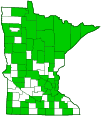snowberry clearwing
(Hemaris diffinis)
Conservation • Description • Habitat • Ecology • Distribution • Taxonomy
|
||||||||
| Hodges # | 7855 |
|||||||
Conservation Status |
||||||||
| IUCN Red List | not listed |
|||||||
| NatureServe | N4N5 - Apparently Secure to Secure SNR - Unranked |
|||||||
| Minnesota | not listed |
|||||||
Description |
||
Snowberry clearwing is a common, colorful, small to medium-sized, day-flying sphinx moth. It has a wingspan of 1¼″ to 2″. It is highly variable in appearance across its range. Fifteen forms have been described. When the adult first emerges from the cocoon the wings are completely covered with reddish-brown scales. The scales begin to drop off with the first flight, eventually leaving the wings clear except on the margins and along the veins. The forewing is long and narrow with a smooth, slightly convex outer margin. It is mostly transparent except at the base; a thin terminal margin with a usually smooth inner edge; an orange apical spot; an orange stripe along the inner margin; and dark scales outlining each vein making them appear bold. The forewing cell is boldly outlined and undivided. The hindwing is mostly transparent except at the base, a thin terminal margin, and bold veins. The thorax is golden-yellow on the sides blending to olive-brown or olive-green with a brown dorsal stripe above. The abdomen is mostly blackish. The first 3 abdominal segments are black. On some freshly emerged individuals there are some blue hairs on the first abdominal segment. The fourth and fifth abdominal segments are yellow above and on the sides and black below, forming a broken band. Tufts of long hairs flare outward from the last abdominal segment and look like feathers. There is often with a patch of golden-yellow to golden-brown hairs in the middle. The head is olive-green or olive-brown above, golden-yellow below. There is a black stripe through the eyes that continues diagonally across the thorax. The antennae are black, thickened, and club-like. The proboscis is long and is coiled under the head when not in use. The legs are black. The caterpillar is up to 1¾″ long. It is usually bluish-green above and yellowish-green on the sides. Sometimes it is entirely brown. The head, thorax, and abdomen are moderately covered with prominent, minute, white bumps (granules). The head is green. The leading edge of the thorax has a yellow collar covered with prominent yellow granules. A long, curved horn extends from the eighth abdominal segment. The horn is yellow at the base, black from the middle to the tip. The spiracles are outlined with a black spot within a white spot. There is a minute white dot within the black spot above and below each spiracle. The leg-like structures (prolegs) are yellowish-green at the base, black in the middle, and dark brown at the end. Mature caterpillars can be found from June onward. |
||
Size |
||
Wingspan: 1⅜″ to 2″ Total length: ⅞″ to 1 3 ⁄16″ |
||
Similar Species |
||
Hummingbird clearwing (Hemaris thysbe) legs are pale. |
||
Habitat |
||
Mostly open areas. Overgrown fields, woodland openings, forest edges, streamsides, powerlines, fencerows, gardens. |
||
Ecology |
||
Season |
||
Two broods: May to early August |
||
Behavior |
||
Adults fly during the day. They are not attracted to light. They do not land on a flower but hover next to it while feeding. Sometimes they extend their forelegs into the flower, possibly to taste it. |
||
Life Cycle |
||
Females attract males by releasing pheromones. After mating, she lays spherical green eggs on the underside of host leaves. The eggs hatch in about one week and the caterpillars begin feeding on leaves and fruit of the host plant. They molt five times in four weeks before pupating. The first generation pupates in a cocoon among the leaf litter on the ground. Adults emerge two to four weeks later. The second generation caterpillar burrows into the soil and overwinters as a pupa and emerges in as an adult in May or June. |
||
Larva Hosts |
||
Northern bush-honeysuckle (Diervilla lonicera), honeysuckle (Lonicera spp.), viburnum (Viburnum spp.), elderberry (Sambucus spp.), and other plants in the Caprifoliaceae (Honeysuckle) family; also snowberry (Symphoricarpos) and dogbane (Apocynum spp.). |
||
Adult Food |
||
Flower nectar. |
||
Distribution |
||||
|
Sources |
|||
| 6/12/2022 | ||||
Occurrence |
||||
Common |
||||
Taxonomy |
|||
Order |
Lepidoptera (Butterflies and Moths) | ||
Superfamily |
Bombycoidea (hawk, sphinx, silk, emperor, and allied moths) | ||
Family |
Sphingidae (sphinx moths) | ||
Subfamily |
Macroglossinae | ||
Tribe |
Dilophonotini | ||
| Subtribe | Hemarina | ||
Genus |
Hemaris (clearwings and bee hawkmoths) | ||
Synonyms |
|||
|
|||
Common Names |
|||
bumblebee moth snowberry clearwing |
|||
Glossary
Proleg
A fleshy structure on the abdomen of some insect larvae that functions as a leg, but lacks the five segments of a true insect leg.
Visitor Photos |
|||||
Share your photo of this insect. |
|||||
| This button not working for you? Simply email us at info@MinnesotaSeasons.com. Attach one or more photos and, if you like, a caption. |
|||||
Lucy Morrissey |
|||||
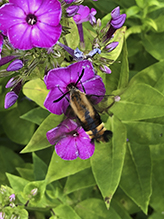 |
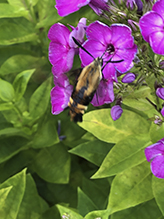 |
||||
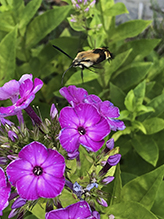 |
|||||
Molly and Robert Power |
|||||
At first I thought this was a large bumble bee, but it turns out it's a hummingbird moth enjoying our honeysuckle! |
 |
||||
Alfredo Colon |
|||||
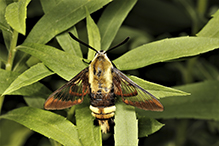 |
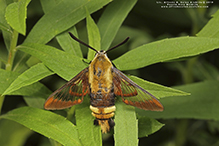 |
||||
Pennie Urban |
|||||
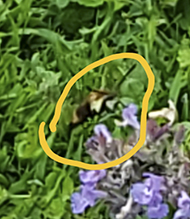 |
|||||
Wayne Rasmussen |
|||||
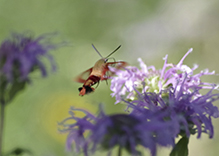 |
|||||
Bill Reynolds |
|||||
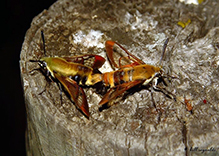 |
|||||
MinnesotaSeasons.com Photos |
|||||
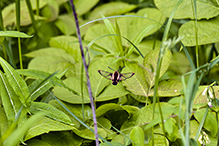 |
|||||


Visitor Videos |
|||
Share your video of this insect. |
|||
| This button not working for you? Simply email us at info@MinnesotaSeasons.com. Attach a video, a YouTube link, or a cloud storage link. |
|||
Felicia Hunt |
|||
| snowberry_clearwing_01 6/26/2020 |
|||
About
Saw June 26th in the evening on some bee blum at my house in Minneapolis (North). |
|||
Other Videos |
|||
| Snowberry Clearwing Moths (Hemaris diffinis) Mark Berman |
|||
About
Published on Aug 18, 2013 Snowberry Clearwind Moths (Hemaris diffinis) nectar feeding on Butterfly Bush (Buddleia davidii) at Chestnut Ridge Metro Park, Ohio. 8-14-13. |
|||
| Hummingbird moth, Hemaris diffinis JUNPonline |
|||
About
Uploaded on Jul 13, 2010 Saw at least 4 of them in a small field with flowering weeds within the First Chain Lake area of Halifax, Nova Scotia. Didn't seem to mind my presense as they were practically flying into the camera. |
|||
| Snowberry Clearwing Moth emchurch |
|||
About
Uploaded on Jul 13, 2011 No description available. |
|||
| Snowberry Clearwing Caterpillar ProjectHEALCreekRun |
|||
About
Published on Sep 18, 2012 Snowberry Clearwing Caterpillar (Hemaris diffinis). Camp Creek Run, Marlton, NJ. September. |
|||
| Hummingbird Moth July 19 Kimber Beckham |
|||
About
Published on Jul 19, 2013 Hummingbird Moth or Snowberry Clearwing (Hemaris Diffinis) (not 100% sure of the identification since I see conflicting IDs online) 7:30 a.m. July 19, Rutland, MA - enjoying an early start to the day getting in his sips of nectar. This is slightly longer better view than I posted to facebook earlier. |
|||


Last Updated:
